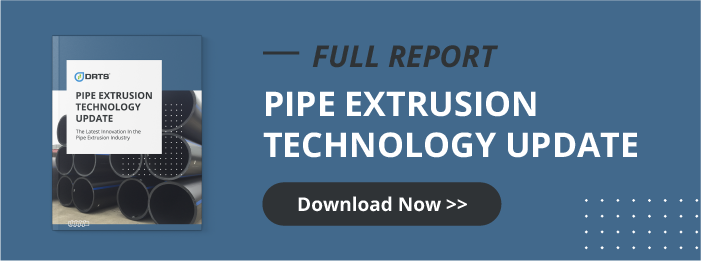The purpose of a gravimetric feeder system is to assure steady and continuous feeding of the extruder with the correct plastics supply rate. This allows every meter of pipe to be produced within specification and with the same material consistency. Gravimetric systems are a high precision technology that dominates the extrusion market. Within the industry gravimetric systems are the best approach to maintaining extruder feeding flow rate control, due to their high accuracy, improved material handling and flexibility.
What is a gravimetric feeder system?
A gravimetric feeder system is comprised of four main parts: the plastics hopper, load cells, feeder, and the PLC controller. The plastic raw materials are loaded in the hopper which is continuously weighed by the load cells. The raw plastic is then sent to the feeder, which feeds the extruder with the correct proportion of the different materials at the required supply rate. The load cells provide constant feedback of the current plastic weights to the PLC controller, which in turn calculates the plastic feeding rate to the extruder in a closed-loop process called “loss-in-weight”, named after it’s operating principle.
Gravimetric feeder system advantages
A gravimetric feeder system is necessary to ensure steady and accurate pipe extrusion operation. This allows for the production of extremely accurate pipe, in terms of pipe composition as well as dimensional characteristics.
Pipe composition
Oftentimes, multiple types of raw plastic materials are mixed with additives to produce pipe according to specification. Such additives are color pigments, impact modifiers and UV light stabilizers. When using two or more raw materials for pipe extrusion, both an accurate and constant material feed rate is required. The solution is to use a gravimetric feeder system with the required number of hoppers, that can provide an necessary material feed rate. In turn this ensures that every meter of produced pipe is made with the same percentage of materials, resulting in stable pipe composition.
Pipe dimensional stability
Gravimetric feeder systems can also assure exceptional pipe dimensional stability, through a mode of operation called “line control system”. In such a system, the PLC of the gravimetric feeder system sends control signals to the extruders controller, adjusting the extrusion speed according to the feed rate of the plastic. This way even if plastics feed rate variations occur, the extruder will adapt accordingly and produce pipe of exceptional dimensional stability throughout the whole pipe extrusion process.
Flexible pipe extrusion operation
The PLC controlled operation of a gravimetric feeder systems also offers the advantage of being easily changed or updated. This makes the changing over from one plastic composition recipe to another, allowing you to produce pipes with different plastic compositions to service different production needs.
Improved material handling
Gravimetric feeder systems also offer complete material containment, since apart from the initial loading or any re-loading instances of plastic that might occur, the raw material is kept sealed within the hopper. Also, due to being PLC controlled, gravimetric feeder systems have the capability to provide complete records of the material handling, such as plastic used per minute of production or per meter of produced pipe, alarms, inventory control, etc.
Learn more with DRTS
Gravimetric feeder systems are one part of the production line than ensures the quality and stability of your extruded pipe products. To discover more about the parts that make up pipe production lines, as well as the latest trends in pipe extrusion technology, download the DRTS 2018 Pipe Extrusion Technology Report.
More from DRTS
The Importance of Plastic Additives in Recycled Materials






